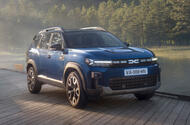Dacia is the Lidl of the car world


The new Bigster is Dacia’s largest, most expensive car yet
Customers priced out of mainstream brands are flocking to Dacia – even as it expands into more expensive segments
Dacias are so much more affordable than their rivals because they are designed, engineered and produced differently.
Parts prices are set from the start, rather than at the end, allowing them to be designed and sourced accordingly and costs to be controlled. Cars are then not overloaded with kit, offering only what Dacia CEO Denis Le Vot calls the “essentials”.
It’s 18 months since I last interviewed Le Vot, in his modern office in Paris, upon receipt of the Sturmey Award at the 2023 Autocar Awards. The trestle table and plastic chair set where we speak this time (at a Car of the Year testing event in Denmark, where Le Vot is making the case for the new Duster) feels a much more Dacia environment, and nothing in the time since has dulled his belief that cars are getting too pricey and an affordable mobility crisis is brewing.
Le Vot relentlessly bangs the drum for value, seeing it almost as a crusade. The more expensive cars get with added technology that drivers haven’t asked for or which legislators require, the closer we get to “a problem in the future of having mobility so expensive that people can’t afford to buy a car any more”.
He proudly calls Dacia the “non-tech company” and says “we put nothing in our cars” that customers don’t need or haven’t asked for.
Le Vot cautions against “the rushing” into new technologies without pause for thought on affordability – yet at the same time he says the Renault Group has responded to legislators’ demands by making electric cars available.
Dacia’s own answer to electric cars is typical of the brand, the £14,995 Spring being the cheapest yet from a European maker.
Dacia’s growth started long before electric cars really took off, yet its message and proposition now only seems more pertinent. At the same time, it has cleverly shifted its self-presentation from ‘cheap’ to ‘value’, with a new logo and brand identity.
To that end, I offer Le Vot the comparison of UK supermarkets Lidl and Aldi, suggesting that they are following Dacia’s approach, in controlling costs and overhauling their brand images to appeal to a much broader audience. He’s now planning a visit.
The thing Le Vot is most proud of is the Sandero being Europe’s best-selling car in the first half of 2024 – proof that his approach is working. He sees no signs of the growth slowing, particularly as Dacia is about to move into the C-segment for the first time with the Bigster.
“The prices of cars [going up] are not stopping here. Every time this happens, we see more people come to us and say: ‘I give up on the main brand and I’m interested in you,’” he says.
Source: Autocar RSS Feed
Recent Posts
NASA Astronaut Don Pettit Uses His Camera for Science in Space
NASA astronaut Don Pettit, known for his incredible astrophotography, sense of humor, and clever camera…
WhatsApp now lets users create their own sticker packs
WhatsApp this week released a major update that adds a new way to create and…
Ben Affleck Has a New Batman Complaint: Wearing the Batsuit Sucked
The actor has long since moved on, but he'll forever be asked about his DC…
LEGO Easter Sale Drops Deals Too Sweet to Miss, Hurry This Won’t Last Long
Dozens of awesome building kits for all ages are marked down from now through April…
This Reminders feature is a lifesaver when my task list grows too long
Apple’s Reminders app has become a powerful task manager in recent years, and there’s one…
Trump Weaponizes Bureaucratic Review to Stop Offshore Wind Project
What happened to cutting red tape?